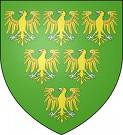The story of the search and discovery for the remains of Richard III in a Leicester car park is the stuff of dreams. It's already creating it's own legend, that Richard was found in a carpark under the letter R - which is not true (the R bit). Much of the painstaking research was carried out by the late historian, and Ricardian fanatic, John Ashdown Hill, although much of the praise is given to Philippa Langley. I had been brought up to believe that Richard's remains were dug up, and thrown into a nearby river, and his stone coffin used as a water rough for horses in the 1700s. Ashdown Hill, though, was convinced otherwise and his research showed he was right. In a simple sentence, there was confusion over 'Grey friars' and 'Black friars' and the reading of a Leicester map. It has of course led others to wonder about the remains of other lost royal tombs. Although in my case, I was intrigued by the lost tomb of Piers Gaveston.
I have always wondered about Piers Gaveston' s lost tomb since my University days in Reading. I knew that the old palace of King's Langley was near Reading, and that there had been a Dominican priory nearby. Edward II had strong memories and an attachment to King's Langley. It's where his parents established the royal nursery, and where Edward probably met Piers for the first time, when he was sent to serve as a squire to Edward, chosen for his chivalrous nature and graceful manners. When Piers died, Edward built him a fine tomb at the established Dominican priory. At University, I discovered that neither the palace or friary existed. All that was left was the name of the village, King's Langley, and some ruins. Subsequently, a school was built on the site. I've always had a feeling that the tomb of Piers, or rather the remains, lay undiscovered somewhere around that school. And if I ever won the lottery, I would definitely set out to try and find it. Below is a sketch of the priory ruin in the 1840's and a photograph from today - both from Wikipedia.
The remains for Edward II's Queen, Isabella, are also lost, as are those of King Stephen. At Reading, there was always talk of the remains of Henry Ist lay undiscovered. Henry had built a magnificent abbey at Reading, and it was hugely important at it's time. Of course Henry VIII put paid to it's survival during the Dissolution of the Monasteries. It's somehow satisfying to learn that none of Henry's children carried out his plans for an elaborate tomb for him at Windsor Castle, and he lies underneath a marble slab in a vault in St George's Chapel.
Henry Ist was buried near the front of the high altar at Reading, with his Queen, Adeliza. During the summer months, a team calling themselves the Hidden Abbey Project, will attempt to map out the Abbey and locate the high altar and hopefully Henry's remains. Built on most of the site is yet another school, and Reading Gaol and it's car park. Will lightening strike twice? and if so, will there be other projects launched to find other lost royal or important tombs? I certainly hope so!

.jpg)


